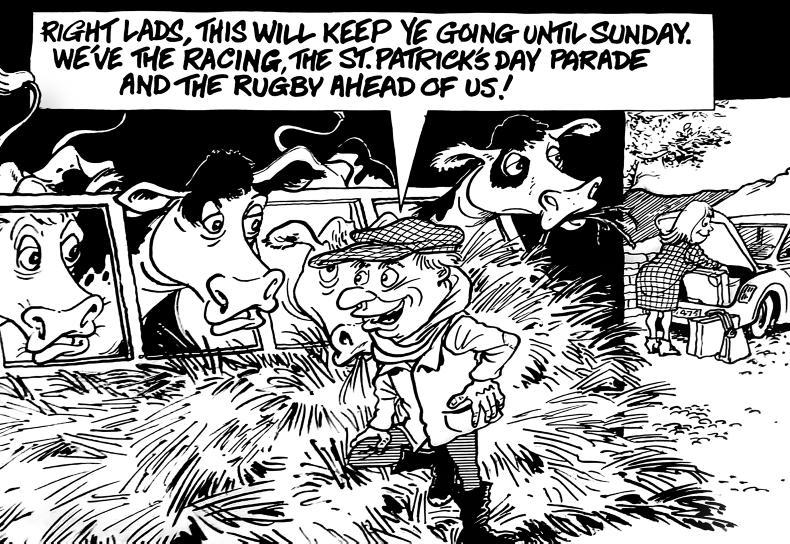The
Irish Farmers Journal Land Price Report published this week for 2022 shows a largely stable land market in the Republic and a significant price rise in Northern Ireland. Without having reliable figures to hand, I would safely say that the price of land for sales completed for the last five to six months in the Republic is showing a much higher price rise, than that recorded for the full year 2022. We have seen a significant price rise in both selling and leasing prices in the last few months of 2022 and the first two months of 2023.
The Irish Farmers Journal Land Price Report published this week for 2022 shows a largely stable land market in the Republic and a significant price rise in Northern Ireland.
Without having reliable figures to hand, I would safely say that the price of land for sales completed for the last five to six months in the Republic is showing a much higher price rise, than that recorded for the full year 2022. We have seen a significant price rise in both selling and leasing prices in the last few months of 2022 and the first two months of 2023.
No doubt land prices are buffered by record output prices for dairy, beef, grain and sheep, tempered somewhat by an ongoing war on the edge of Europe driving input costs skyward.
The key driver of the rise is undoubtedly the direction of EU policy, with an Irish twist from our Department of Agriculture. Similar environmental policies in Northern Ireland buoyed by overwhelming demand in a tight supply market saw prices rise significantly in 2022.

While the Nitrates Directive might be primarily a dairy industry challenge, increasingly it is turning into a much bigger challenge for the suckler, sheep and tillage sectors as they lose ground to progressive dairy farmers buoyed by the exceptional milk prices in 2022.
The other key demand driver for more and more land sales seems to be what I’ll call outside money coming in to invest in land. This investment money, often generated outside core farming, is underpinning a number of sales and making land much more expensive for full-time farmers to purchase. Of course, some of these farmers are part-time farmers working full-time off-farm. More are large businesses that see an opportunity to transfer wealth or gain tax efficiencies, or are businesses that simply want to invest in an asset class that has and continues to go one direction and that is up and up.
Drivers of change
When considering land lease or purchase, there is no doubt farmers are looking at the direction of travel of EU and Irish farm policy. For example, new nitrates restrictions, new forestry schemes, new land designations, more land for rewetting, energy production and lower stocked organic schemes all have the capacity to soak up more and more acres. All mean less land is available for the traditional beef, dairy, sheep and tillage sectors. So the supply of land coming on the market remains small while the demand continues and maybe even intensifies as outside money flows into land purchase. We have seen the number of full-time farmers buying land drop from 75% five years ago to almost 50% in 2022.
I asked four or five people this week if land has become too expensive. The answers varied from “very definitely yes”, all the way to “it has a bit to go yet”.
The truth is underpinned by repayment capacity. Many feared the end of quotas would flood global milk markets and drop milk price through the floor. Hailing the end of quotas, we were warned to find refuge if milk price plummeted post 2015. The reality is the milk price has risen almost every year since 2015. As we near an eight-year anniversary post quota removal, we have seen milk price rise to reach new heights in 2022. However, the shine is very quickly coming off right now as January and February milk prices have dropped like a stone with swingeing milk price cuts that the industry has never experienced.
Let’s not forget, as the fixed-milk-price farmers found out the hard way, it’s not about locking in price, it’s about locking in margin.
Investment
Much like during the property investment boom, maybe farmers are deciding it’s better to invest in the farm and family where you get a return every day.
Like any investment, the decision to buy or lease is very particular to the farm situation.
We can say what we like about winners and losers in CAP, the long and short of it is that there is a new CAP up and running that guarantees another five years of farm payments at a minimum. While the payments are going backwards in real terms, any farm payment does help big decisions like land purchase and lease.
The Irish Farmers Journal Land Price Report takes significant effort to compile – thanks to Paul Mooney, Peter McCann and Andy Doyle for leading the editorial team on that.
Genotyping success crucial for industry It looks like a new national genotyping scheme is going to get off the ground, and the benefits would be significant to the dairy and beef industries.
It would remove, or at least streamline, the need for some work at farm and at factory level. Parentage error at farm level would be removed. DNA testing at factory level would not be necessary. It would allow for more accurate methane data to inform better science. Significantly, it would bring better information and transparency to those buying calves and weanlings in marts as it would underpin the commercial beef value (CBV) index if we have genotype information verified. This would drive uptake in CBV and drive better values that farmers could trust to deliver.
Fair play to the various players for getting the project this far. The sooner it’s moved on and delivered, the better for farmers.





SHARING OPTIONS: